Are you mesmerized by the delightful dance of hummingbirds and want to attract them to your garden? If so, you might wonder if these vibrant flyers are attracted to hibiscus flowers. The answer is a resounding yes! But that’s not all — hummingbirds are drawn to a variety of other blossoms too. And you can plant all these flowers in your garden to attract these amazing pollinators! Plus, you can turn your garden into an oasis where your friends and family can view and observe these fascinating birds.
This article is your guide to understanding the relationship between hummingbirds and hibiscus, providing useful tips on how to grow these flowers successfully and unveiling other floral varieties that these tiny feathered creatures absolutely love. So, get ready to make your garden a hummingbird heaven!
Do Hummingbirds Like Hibiscus?
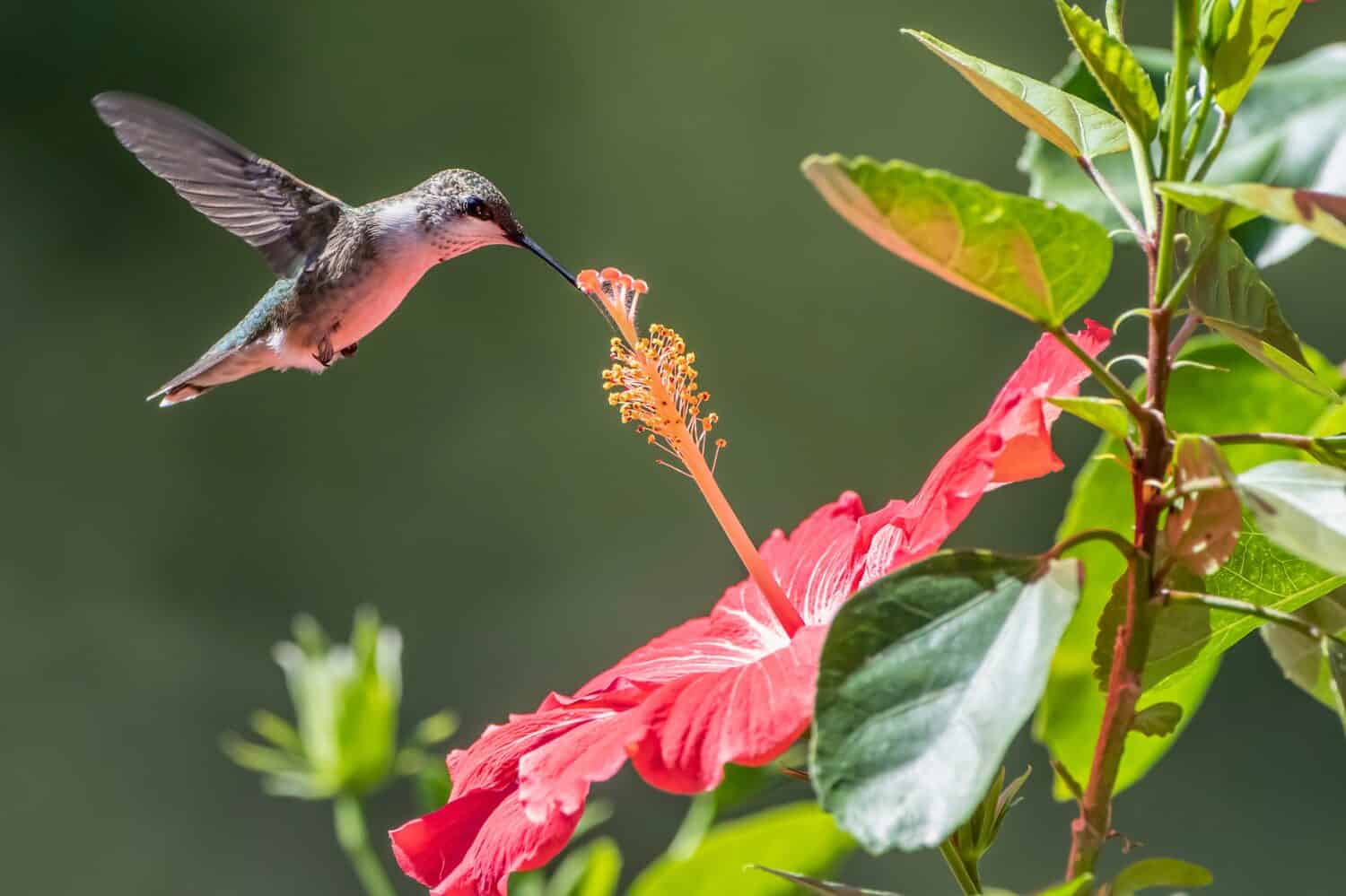
One of the best flowers to plant in your garden to attract hummingbirds is the hibiscus.
©Bonnie Taylor Barry/Shutterstock.com
Hummingbirds, part of the Trochilidae family, originally hail from the Americas. Their kind is quite diverse, with over 350 species found across 115 groups or genera. They’re scattered across the American continents, from Alaska to Southern Argentina, with most species found in Central and South America.
You may be surprised to know that these small birds eat a lot! They consume around half their body weight in insects and nectar. They feed every 10 to 15 minutes and visit an impressive 1,000 to 2,000 flowers in a single day.
Meanwhile, hibiscus is a type of flowering plant in the mallow, or Malvaceae, family. It’s a big group of flowering plants with several thousands of species across 244 genera! These flowers grow in warm temperate, subtropical, and tropical places all over the world.
So, to answer the question: do hummingbirds like hibiscus? Yes, they absolutely do! In fact, the bright, tube-like flowers of the hibiscus and the speedy hummingbirds are a perfect pair in any garden. In fact, it almost seems like hibiscus flowers were made just for hummingbirds, with their bright colors and shape, which lets hummingbirds easily get to the nectar hidden inside.
But hibiscus flowers aren’t just loved by hummingbirds. They also attract a variety of other pollinators, which helps your garden grow. And because hibiscus flowers keep blooming all summer, they’re a favorite stop for hummingbirds.
The shape of a hibiscus flower is also a big draw for hummingbirds. Usually, these flowers have five petals that provide a comfortable landing spot and easy access for the bird’s beak. This lets them hover just outside the flower while they sip on the sweet nectar.
How to Grow Hibiscus

The ideal zones for growing hibiscus are zones 4 to 9, but they can also survive in 10 to 12 (albeit not in the winter).
©Ward DeWitt/ via Getty Images
If you love gardening and are fascinated by hummingbirds, you might be curious if planting hibiscus flowers could lure these charming birds into your garden. As you know by now, the answer is absolutely yes! But knowing that hibiscus attracts hummingbirds is only a part of the work. Now you need to figure out how to grow it in order to attract the hummingbirds to your backyard. Here are some of our top tips to help you grow this beautiful flower in your garden!
Color Choices: Bright colors catch the eye of hummingbirds. Hibiscus flowers are perfect as they bloom in many vibrant shades. Pick from red, orange, or pink ones to appeal to your tiny, winged visitors.
Placement: Hibiscus plants adore warmth and do best in sunny corners of your garden. This works great as hummingbirds also get attracted to warm, sun-filled spots. The best zones for planting hibiscus range from zones 4 to 9, as perennial hibiscus flowers can survive the winter here. However, always confirm the specific growth needs of your selected hibiscus type. In zones 10 to 12, these flowers do grow well in the summer but won’t survive the winter.
Don’t forget that having a range of flowers that bloom at various times guarantees a steady flow of nectar, ensuring your garden remains buzzing with hummingbirds.
Types of Hibiscus for Your Garden
Your garden conditions could help you decide which hibiscus variety to plant. Each kind of hibiscus is special in its own way, and hummingbirds are fans of them all. Here are some recommendations to make things easier!
Hardy Hibiscus (Hibiscus moscheutos)
These plants are a great choice for cooler climates. In winter, they disappear into the ground, only to grow back once spring arrives, as long as they are in the right growing zone.
Tropical Hibiscus (Hibiscus rosa-sinensis)
This is the most common hibiscus type, known for its big, shiny leaves and brightly colored flowers. They’re ideal for warmer areas and need to be kept indoors when winter comes.
Rose of Sharon (Hibiscus syriacus)
This hibiscus type grows like a shrub or a small tree and is sturdy enough to handle cooler climates as low as -20 degrees Fahrenheit or -29 degrees Celsius. It shows off its flowers in late summer, a time when most other plants have finished blooming.
Growing Tips
Growing hibiscus is a relatively simple process, and with proper care, these plants will add a spectacular burst of color to your garden during the summer. Here are some tips to help you successfully grow hibiscus:
When to Plant
Opt for the spring season if you live in a colder climate. If you live in a milder area, summer works fine too. If you are using small plants or cuttings with roots, ensure the risk of frost is gone.
Planting from Seeds
A straightforward process — start in early winter, roughly 12 weeks before the last expected frost. Once the frost risk is over, move the plants outside.
Location
Hibiscus plants don’t fare well in strong winds. Choose a sheltered location where they can get plenty of sunlight. In extremely hot areas, some afternoon shade would be beneficial.
Watering
Hibiscus plants enjoy the water but avoid waterlogged roots to prevent root rot. For the initial weeks after planting, water every few days. During the first growing season, water twice a week. Mature plants, on the other hand, are relatively drought-resistant.
Soil Requirements
Opt for slightly acidic soil rich in organic matter and nutrients, capable of retaining moisture. Hibiscus plants can tolerate clay-heavy soil; if it’s too dense, add coarse sand for better drainage.
Temperature Tolerance
Tropical hibiscus plants need to be kept indoors during colder months, unlike their hardy counterparts, which can withstand a cooler climate. But again, make sure you are in the right zones beforehand!
Fertilizer
Hibiscus plants are heavy feeders, particularly in bloom. Fertilize every two weeks during the growing season, and increase this to weekly during blooming. No fertilization is needed in winter.
Pests
Keep an eye out for pests and diseases, especially in new plants. These can be more susceptible due to their tender foliage.
Alternative Flowers That Attract Hummingbirds
While hibiscus flowers are undoubtedly attractive to hummingbirds, they are not the only option available to invite these flying jewels into your garden. Let’s explore some fantastic alternatives that will surely charm and attract hummingbirds to your outdoor haven!
1. Scarlet Bee Balm (Monarda didyma)
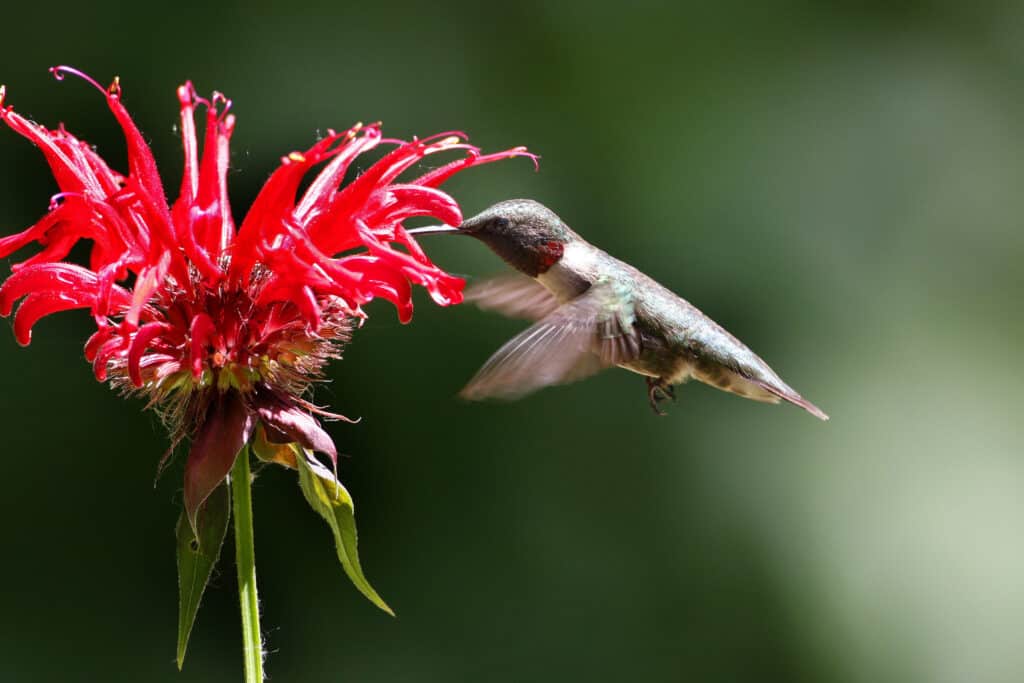
One of the best flowers to plant in your garden to attract hummingbirds is the scarlet bee balm.
©Chris Alcock/Shutterstock.com
Scarlet bee balm is a perennial plant appreciated for its bright blossoms and refreshing mint-like scent. It showcases a splendid display of red, two-lipped flowers arranged in dense, round heads measuring around 3 to 4 inches across.
It enjoys a long flowering period, typically from late spring to mid-fall, and the vibrant color and aromatic nectar are irresistible to bees, butterflies, and of course, hummingbirds.
This plant needs a balance between sun and shade, nutrient-rich soil, and well-regulated moisture. It does well in full sunlight but can benefit from some shade during hot summer afternoons. The soil should be moist but well-draining, so avoid waterlogging. Ensure the plant isn’t dried out in the summer and protect it from excessive wet conditions in winter. Also, it’s crucial to provide good air circulation around the plant to prevent powdery mildew.
In summary, the vivid color of scarlet bee balm’s flowers, combined with its nectar, makes it a major hummingbird draw. Plant some in your garden and watch the hummingbirds flock in!
2. Reblooming Daylily (Hemerocallis ‘Stella D’Oro’)
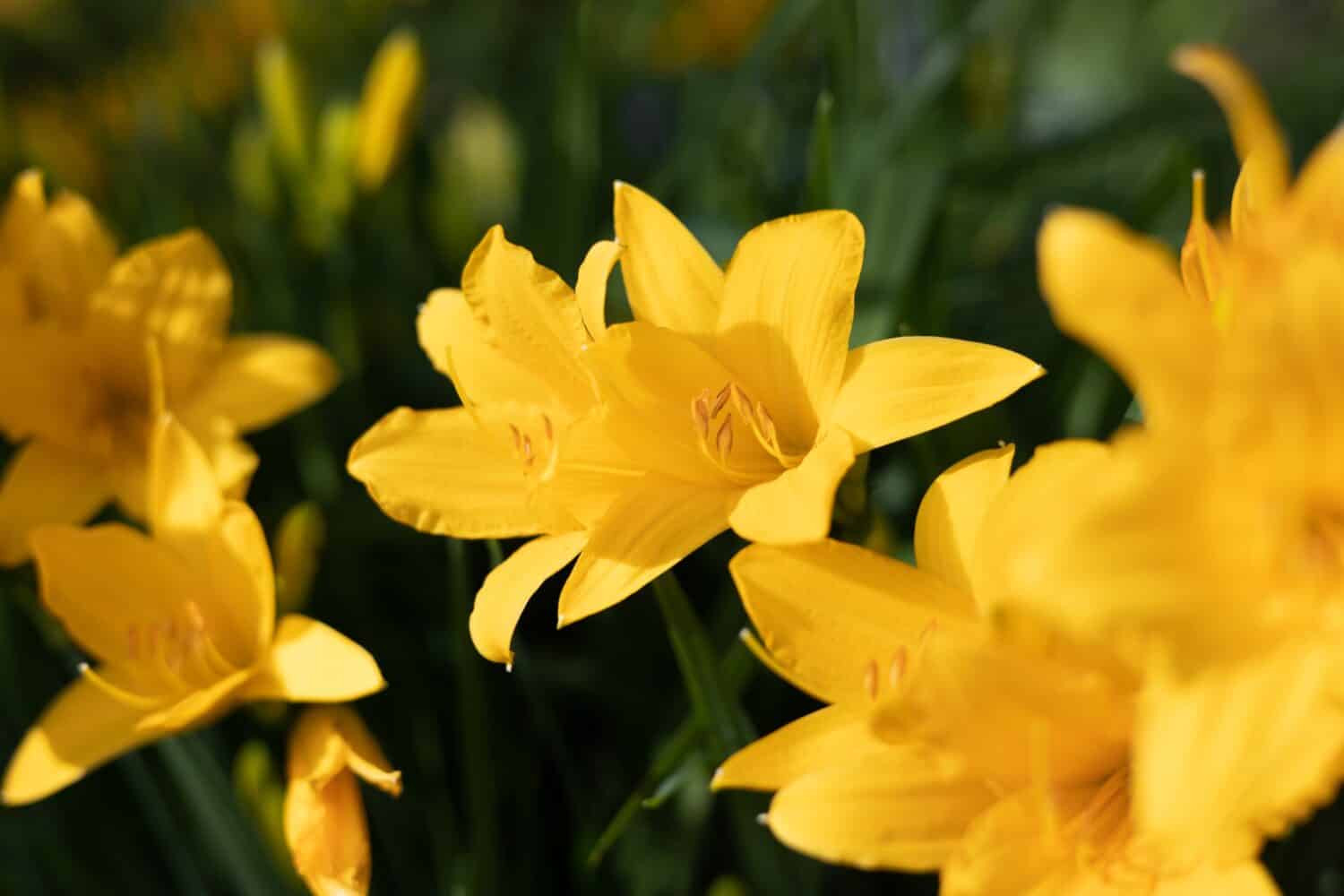
With its lengthy bloom time, reblooming daylilies are perfect to attract hummingbirds.
©DiandraNina/Shutterstock.com
Reblooming daylilies hold a special place for their compact size, robust nature, fragrance, and, notably, their prolonged flowering period. This smaller variety of daylily delivers a bounty of ruffle-edged blooms, contrasting beautifully with their green cores.
Each flower, about 2.75 inches wide, unfolds for a day, opening in the morning and wilting by nightfall. Yet, don’t be disappointed; another bloom is likely to replace it the next day on the same stalk, hence the name!
Daylilies are versatile; they flourish in full to partial sunlight and prefer average, moist, but well-draining soils. They show optimal growth in nutrient-rich loam but can adapt to a variety of soil conditions. These plants can withstand hot weather and summer humidity, but to keep their foliage lush and appealing, consistent watering is necessary.
What sets this flower apart for hummingbird lovers is its lengthy bloom time. The constant supply of fresh flowers presents an abundant nectar source, making your garden a go-to destination for these delightful birds.
3. Large-Leaved Lupine (Lupinus polyphyllus)

The large-leaved lupine is a perennial showcasing clusters of flowers that attract hummingbirds.
©Nadya So/Shutterstock.com
Known for its striking presence, the large-leaved lupine is a sturdy perennial plant adored for its large, deep-green, palm-shaped leaves split into 9 to 17 leaflets. It presents an impressive show of tall, densely packed clusters of flowers, ranging from a deep blue to purple, taking the shape of a pea.
These flowers bloom in the late spring, situated on upward-reaching stems that rise well above the leafy base. Hummingbirds, butterflies, and many other pollinators find them irresistible. Particularly stunning when planted en masse in a wetland garden, the bigleaf lupine is a showstopper.
This plant thrives in full sunlight and prefers moist, well-draining soils. As it is relatively low maintenance and resistant to deer, the large-leaved lupine is an even more attractive choice for many gardeners.
With its bright and striking flowers, extended blooming period, and rich nectar, the large-leaved lupine is a surefire way to make your garden a preferred pit stop for hummingbirds!
4. Hummingbird Mint (Agastache ‘Bolero’)
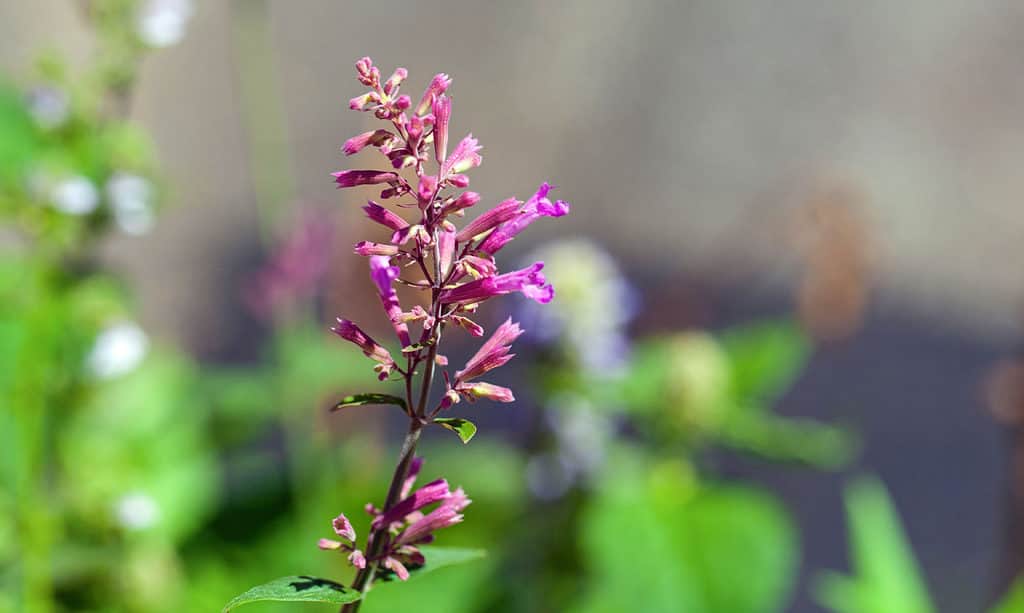
An upright perennial, the hummingbird mint blooms over weeks.
©ChWeiss/Shutterstock.com
Hummingbird mint is an upright, compact perennial that forms a small mound of bronze-hued leaves. From midsummer until fall, it displays an abundance of rose-purple blooms, creating a stunning spectacle in your garden. Its continuous blooming over weeks makes it a centerpiece in beds, borders, or pots and a prime feeding spot for hummingbirds.
This plant flourishes best in sunny locations with average, well-draining soil that ranges from dry to moderately moist. Good drainage is crucial for its healthy growth. While it is generally resistant to drought, prolonged periods of dry weather might call for additional watering to keep it thriving.
With its prolonged blooming season and vibrant, nectar-rich flowers, hummingbird mint is a must-visit flower for hummingbirds!
5. Trumpet Vine (Campsis radicans)
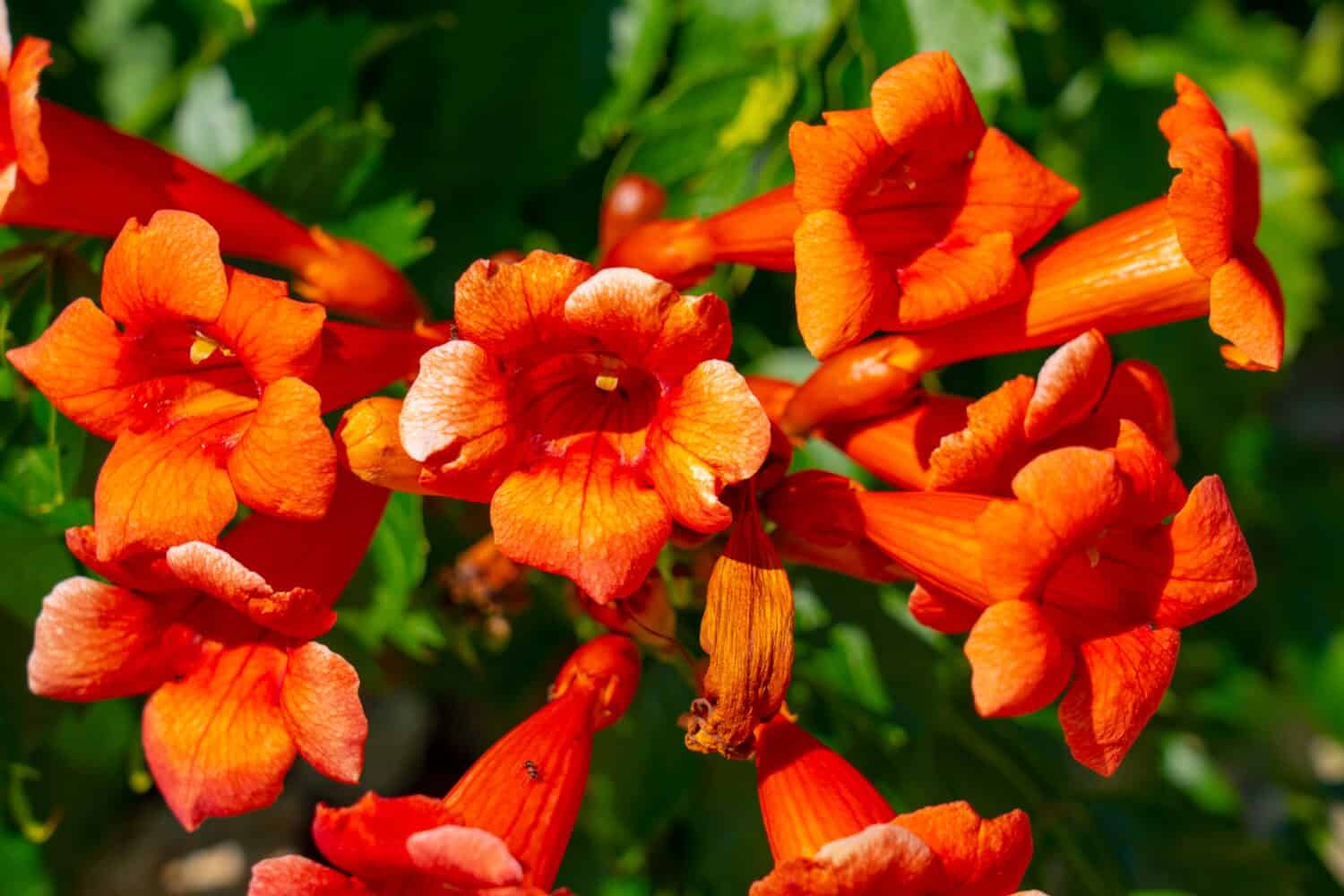
Besides hibiscus, the trumpet vine is another great flower to plant in your garden to attract hummingbirds.
©martin.dlugo/Shutterstock.com
Aiming to invite hummingbirds to your garden? Consider planting a trumpet vine! This robust, native North American climber is known for its spectacularly vibrant trumpet-shaped flowers, each about 3 inches long, in bright hues of orange or red. The flowers emerge all summer long, forming clusters at the branch ends for an impressively long and remarkable floral spectacle, which hummingbirds find irresistible.
This trumpet vine flourishes from early to late summer, demonstrating its resilience to heat, cold, and drought. It prefers moderately moist, well-drained soils that are lean to average under full sun or partial shade. Yet, it can adapt to a broad range of soil types, even dry ones, showcasing its tolerance. Maximum flower production is achieved under full sun exposure.
Incorporating a trumpet vine into a pollinator or hummingbird garden guarantees a flurry of winged visitors all through the summer. With its long-lasting bloom, your garden will flaunt a wealth of flowers for months. Nonetheless, regular pruning is recommended to keep this vigorous plant in check.
Other Ways To Attract Hummingbirds To Your Garden

A hummingbird feeder (pictured above) is another way to attract these fast birds to your garden.
©Jeff Westhead/Shutterstock.com
In addition to growing plants that attract hummingbirds, you can boost your garden’s charm for these birds by incorporating other features that meet their unique behaviors and requirements.
Water Access: Hummingbirds love to bathe and hydrate. Including a shallow birdbath or a water sprayer in your garden could be an excellent way to draw them in.
Hummingbird Feeders: Enhance the appeal of your flowering plants with a hummingbird feeder brimming with DIY nectar, a solution of 1 part white sugar and 4 parts water.
Resting Spots: Supplying places to perch, like slim branches or wires, provides hummingbirds with a spot to take a breather or even to vigilantly guard their preferred blooms.
Pesticide-Free Garden: Aim to minimize pesticide use in your garden as much as you can. Pesticides can eliminate the tiny insects that hummingbirds depend on for their protein intake.
By following these tips, you’re setting up a hummingbird-friendly habitat that infuses your garden with vibrancy and charm. Observing these fascinating birds as they zip and hover around your garden will be a delightful sight, making your gardening endeavors truly rewarding.
Summary of Flowers Hummingbirds Love
| Flower | Botanical Name |
|---|---|
| Hibiscus | Hibiscus |
| Scarlet Bee Balm | Monarda didyma |
| Reblooming Daylily | Hemerocallis ‘Stella D’Oro’ |
| Large-Leaved Lupine | Lupinus polyphyllus |
| Hummingbird Mint | Agastache ‘Bolero’ |
| Trumpet Vine | Campsis radicans |
Thank you for reading! Have some feedback for us? Contact the AZ Animals editorial team.







